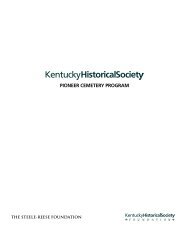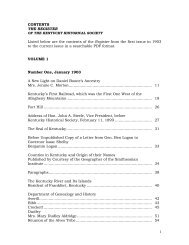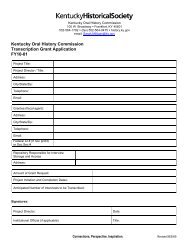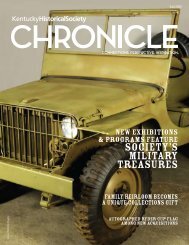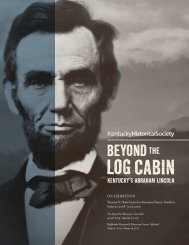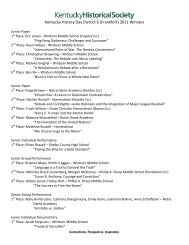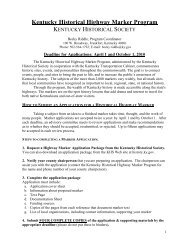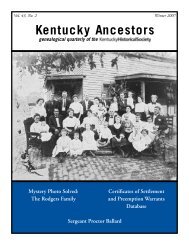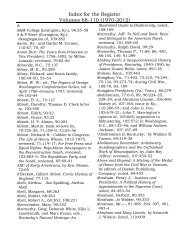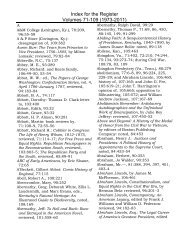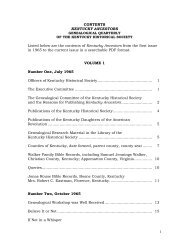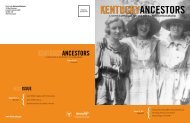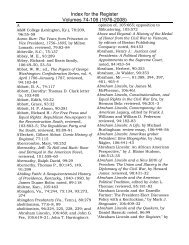Kentucky Ancestors, Volume 46, Number 2 - Kentucky Historical ...
Kentucky Ancestors, Volume 46, Number 2 - Kentucky Historical ...
Kentucky Ancestors, Volume 46, Number 2 - Kentucky Historical ...
You also want an ePaper? Increase the reach of your titles
YUMPU automatically turns print PDFs into web optimized ePapers that Google loves.
of negro and mulatto paupers kept in<br />
each county, and upon such certificate<br />
draw their proportion of the fund set<br />
apart in this Act for that purpose. Said<br />
reports shall be made by said courts at<br />
their annual court of claims. Chapter 88<br />
of the Revised Statutes, and amendments<br />
thereto, shall regulate the mode and<br />
manner of distributing the school fund<br />
realized under this Act; but no part of said<br />
fund shall ever be drawn or appropriated<br />
otherwise than pursuant to this Act in<br />
aid of common schools for negroes and<br />
mulattoes. The Auditor shall apportion<br />
each year the revenue from the fund<br />
realized under this Act for the benefit of<br />
said paupers among the several counties<br />
of the State according to the number of<br />
said paupers in each county, as shown by<br />
the reports of the several county courts.<br />
Nothing in this Act shall be construed as<br />
interfering with the rights of the county<br />
courts in levying county taxes. This Act<br />
shall take effect from its passage. 4<br />
This act was amended on 9 March 1867. On 7 April<br />
1873, the General Assembly declared the provisions<br />
of this act did not apply to the city of Bowling<br />
Green. The city government was authorized to levy<br />
an additional tax of $1.00 on every male person of<br />
African descent over the age of twenty-one years. The<br />
tax money was to be used to establish a fund for a<br />
“free school” for children between the ages of six and<br />
twenty years of African descent in Bowling Green. 5<br />
1866 (16 February)<br />
The legislature deferred to 1868 the collection of<br />
the revenue tax in Wayne County for the years 1862,<br />
1863, and 1864. The back taxes were to be collected<br />
with the taxes for 1868. 6 In 1866 the legislature also<br />
extended the time for collecting the revenue tax in<br />
Clinton County to 1868 for the years 1862, 1863,<br />
and 1864 in Chapter 848.<br />
Decius Priest, the late sheriff of Henderson<br />
County, was granted two years from the passage of<br />
this legislation to list for collection with the sheriff of<br />
the county all his uncollected fee bills and taxes for<br />
1861-62, “subject to all the pains and penalties now<br />
in force for issuing and collecting illegal fee bills.” 7<br />
76 | <strong>Kentucky</strong> <strong>Ancestors</strong><br />
1866 (17 February)<br />
Jeff J. Wood, the late sheriff of Clinton County,<br />
was released from the collection of the uncollected<br />
military tax for the year 1862. 8<br />
1867 Key Points of Chapter 83, <strong>Kentucky</strong> Revised<br />
Statutes: “Revenue and Taxation”<br />
(Note: Chapter 83 was later renamed Chapter 92)<br />
The tax rate was $.17 per each $100 of value for<br />
real and personal estate. Ten cents of that amount was<br />
designated for the ordinary expenses of government;<br />
five cents for the use of the sinking fund; and two<br />
cents for the support of common schools. (Note: The<br />
tax rate was increased to forty cents per one hundred<br />
dollars of value in 1876.) Personal estate was<br />
described as: gold, silver, and other metallic watches;<br />
clocks composed, in whole or in part, of metal or<br />
wood; gold and silver plate; piano-fortes; riding or<br />
pleasure carriages, buggies, and gigs; stage coaches,<br />
omnibuses, and “all descriptions of vehicles for the<br />
transportation of persons or passengers, by whatever<br />
name known or called, including the harness thereof,<br />
whether in use or not” taxed at the rate of thirty cents<br />
per $100 of the value thereof, “except such as are<br />
kept for sale in the store or shop of any merchant or<br />
manufacturer thereof. These shall be taxed as other<br />
estate owned by the merchant or manufacturer.”<br />
Taxes were due and payable in the same year in which<br />
the estate was assessed. The commonwealth had a<br />
lien for the revenue and county levy on the estate of<br />
each person assessed for taxation, “which shall not be<br />
defeated by sale or alienation.”<br />
Specific tax rates were set for: bank stocks, stocks<br />
in moneyed corporations of loan or discount, and the<br />
gross amount from the sales of drugs, medicines, or<br />
nostrums.<br />
The license tax for businesses included $10.00<br />
for keeping a tavern, coffee house, or other place<br />
for selling “spirituous liquors.” The license tax for<br />
merchants who sold spirituous liquors was $5.00,<br />
however such licenses were granted by the county<br />
court “upon satisfactory evidence that the applicant<br />
was, in good faith, a merchant, and his business was<br />
that of retailing merchandise and he had not assumed<br />
the name and business of a merchant with the view<br />
and object of obtaining a license to sell spirituous<br />
liquors.”<br />
After February 1858, county courts were given




